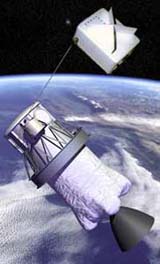SEDS (Small Expendable-tether Deployer System)
SEDS (Small Expendable-tether Deployer System) was an experiment developed by the Marshall Space Flight Center and Tether Applications Co., of San Diego, California, to demonstrate the use of a space tether to de-orbit a small payload.
 |
| SEDS-1
|
Two SEDS missions have been flown to date. Each involved the deployment of a 20-kilometer tether at the downward end of which was the de-orbit. The principle is that the tether acts as a thruster causing the lower satellite to hover at an altitude below that which the orbital angular rate would allow, thus causing the orbit to decay. SEDS-1 and SEDS-2 were both successful, although the SEDS-2 tether was severed after five days by a micrometeroid or piece of space debris.
NASA has successfully deployed three SEDS Class (Small Expendable Deployer System) probes: SEDS-1 and -2 were 20-km missions and PMG (Plasma Motor Generator) was a 500-meter mission. All tethered systems were attached to a spent Delta second stage. Not only were tether models verified, it was demonstrated that a probe can be downwardly deployed from a very long tether.
See also TSS (Tethered Satellite System) and ProSEDS (Propulsive Small Expendable Deployer System.
| spacecraft | launch date | launch vehicle | orbit | mass |
| SEDS 1 + deployer | Mar 30, 1993 | Delta 7925 | 195 × 705 × 34° | 25 kg |
| SEDS 2 + deployer | Mar 10, 1994 | Delta 7925 | 350 km (circular) | 25 kg |


